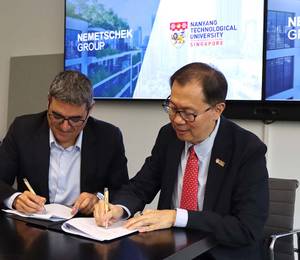The consortium of Tuas Power and ST Engineering, along with PUB, Singapore’s National Water Agency, have officially opened Singapore’s fifth desalination plant located on Jurong Island. Constructed under the design, build, own and operate (DBOO) model, the new Jurong Island Desalination Plant (JIDP) has a daily capacity of up to 137,000 cu m – the equivalent of 55 Olympic-sized swimming pools of water.
The facility will be operated by TP-STM Water Resources Pte Ltd – the Joint Venture company formed by the Tuas Power-ST Engineering consortium – for a 25-year period. Spanning over 3.7 ha, which is about the size of five football fields, JIDP receives seawater from Tuas Power’s Tembusu Multi-Utilities Complex (TMUC) for processing into potable water.
JIDP’s co-location with TMUC allows it to derive synergies in resources such as sharing of seawater intake and outfall structures, as well as energy from in-plant generation facilities. According to PUB, due to the co-location, the plant is about 5% more energy efficient compared to conventional desalination plants, which translates to annual energy savings sufficient to power nearly 1,000 HDB households.
Building a full-fledged desalination plant on existing infrastructure called for innovative engineering solutions, from creating modular systems in different areas of the desalination process to the pre-fabrication of equipment such as the reverse osmosis units. The plant is also highly automated – a three-man team can run the entire plant’s operations from its control room. In addition, JIDP incorporates the latest proven water treatment equipment and membrane technologies such as dissolved air flotation, ultra-filtration, and reverse osmosis.
“Although seawater desalination is the most expensive way to produce water, due to the energy required, it is nevertheless an essential source of drinking water for Singapore,” explained Ng Joo Hee, chief executive of PUB. “Desalination is immune to the vagaries of weather and always available, rain or not. The efficiencies that come from constructing JIDP, our fifth and newest desalination plant, next to Tuas Power’s existing TMUC make the energy-take for desalination.”
“The design and construction of the JIDP has provided ST Engineering the opportunity to leverage our expertise in large scale engineering projects in the marine sector to deliver complex environmental engineering solutions. The result is an energy efficient, technologically advanced, less labour intensive and weather-resilient water source that meets Singapore’s water needs." said Ng Sing Chan, president of marine at ST Engineering.
“Leveraging on TMUC’s existing infrastructure for seawater intake, the synergies between JIDP and TMUC have enabled operations to save approximately 5,000 MWh per year. That is almost 1,000 HDB households’ energy consumption annually, making JIDP one of the more energy efficient desalination plants in Singapore,” shared Jiang Hanbin, president and CEO of Tuas Power.
Desalinated water is one of Singapore’s Four National Taps, and a weather-resilient source that contributes to the nation’s long-term water supply sustainability. The other four desalination plants in Singapore are the Singspring (2005), Tuas South (2013), Tuas (2018) and Marina East (2020) plants.
All images: PUB












